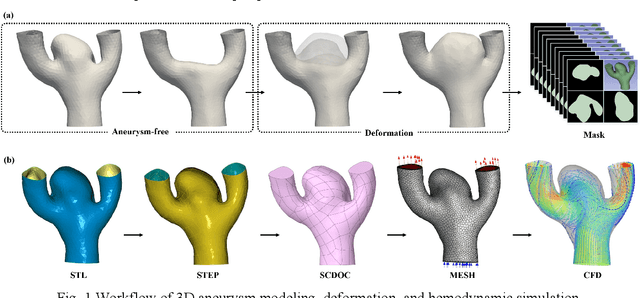Chensen Lin
Aneumo: A Large-Scale Comprehensive Synthetic Dataset of Aneurysm Hemodynamics
Jan 17, 2025
Abstract:Intracranial aneurysm (IA) is a common cerebrovascular disease that is usually asymptomatic but may cause severe subarachnoid hemorrhage (SAH) if ruptured. Although clinical practice is usually based on individual factors and morphological features of the aneurysm, its pathophysiology and hemodynamic mechanisms remain controversial. To address the limitations of current research, this study constructed a comprehensive hemodynamic dataset of intracranial aneurysms. The dataset is based on 466 real aneurysm models, and 10,000 synthetic models were generated by resection and deformation operations, including 466 aneurysm-free models and 9,534 deformed aneurysm models. The dataset also provides medical image-like segmentation mask files to support insightful analysis. In addition, the dataset contains hemodynamic data measured at eight steady-state flow rates (0.001 to 0.004 kg/s), including critical parameters such as flow velocity, pressure, and wall shear stress, providing a valuable resource for investigating aneurysm pathogenesis and clinical prediction. This dataset will help advance the understanding of the pathologic features and hemodynamic mechanisms of intracranial aneurysms and support in-depth research in related fields. Dataset hosted at https://github.com/Xigui-Li/Aneumo.
Bridging scales in multiscale bubble growth dynamics with correlated fluctuations using neural operator learning
Mar 20, 2024Abstract:The intricate process of bubble growth dynamics involves a broad spectrum of physical phenomena from microscale mechanics of bubble formation to macroscale interplay between bubbles and surrounding thermo-hydrodynamics. Traditional bubble dynamics models including atomistic approaches and continuum-based methods segment the bubble dynamics into distinct scale-specific models. In order to bridge the gap between microscale stochastic fluid models and continuum-based fluid models for bubble dynamics, we develop a composite neural operator model to unify the analysis of nonlinear bubble dynamics across microscale and macroscale regimes by integrating a many-body dissipative particle dynamics (mDPD) model with a continuum-based Rayleigh-Plesset (RP) model through a novel neural network architecture, which consists of a deep operator network for learning the mean behavior of bubble growth subject to pressure variations and a long short-term memory network for learning the statistical features of correlated fluctuations in microscale bubble dynamics. Training and testing data are generated by conducting mDPD and RP simulations for nonlinear bubble dynamics with initial bubble radii ranging from 0.1 to 1.5 micrometers. Results show that the trained composite neural operator model can accurately predict bubble dynamics across scales, with a 99% accuracy for the time evaluation of the bubble radius under varying external pressure while containing correct size-dependent stochastic fluctuations in microscale bubble growth dynamics. The composite neural operator is the first deep learning surrogate for multiscale bubble growth dynamics that can capture correct stochastic fluctuations in microscopic fluid phenomena, which sets a new direction for future research in multiscale fluid dynamics modeling.
FuXi-S2S: An accurate machine learning model for global subseasonal forecasts
Dec 15, 2023Abstract:Skillful subseasonal forecasts beyond 2 weeks are crucial for a wide range of applications across various sectors of society. Recently, state-of-the-art machine learning based weather forecasting models have made significant advancements, outperforming the high-resolution forecast (HRES) from the European Centre for Medium-Range Weather Forecasts (ECMWF). However, the full potential of machine learning models in subseasonal forecasts has yet to be fully explored. In this study, we introduce FuXi Subseasonal-to-Seasonal (FuXi-S2S), a machine learning based subseasonal forecasting model that provides global daily mean forecasts up to 42 days, covering 5 upper-air atmospheric variables at 13 pressure levels and 11 surface variables. FuXi-S2S integrates an enhanced FuXi base model with a perturbation module for flow-dependent perturbations in hidden features, and incorporates Perlin noise to perturb initial conditions. The model is developed using 72 years of daily statistics from ECMWF ERA5 reanalysis data. When compared to the ECMWF Subseasonal-to-Seasonal (S2S) reforecasts, the FuXi-S2S forecasts demonstrate superior deterministic and ensemble forecasts for total precipitation (TP), outgoing longwave radiation (OLR), and geopotential at 500 hPa (Z500). Although it shows slightly inferior performance in predicting 2-meter temperature (T2M), it has clear advantages over land area. Regarding the extreme forecasts, FuXi-S2S outperforms ECMWF S2S globally for TP. Furthermore, FuXi-S2S forecasts surpass the ECMWF S2S reforecasts in predicting the Madden Julian Oscillation (MJO), a key source of subseasonal predictability. They extend the skillful prediction of MJO from 30 days to 36 days.
FuXi-Extreme: Improving extreme rainfall and wind forecasts with diffusion model
Oct 25, 2023Abstract:Significant advancements in the development of machine learning (ML) models for weather forecasting have produced remarkable results. State-of-the-art ML-based weather forecast models, such as FuXi, have demonstrated superior statistical forecast performance in comparison to the high-resolution forecasts (HRES) of the European Centre for Medium-Range Weather Forecasts (ECMWF). However, ML models face a common challenge: as forecast lead times increase, they tend to generate increasingly smooth predictions, leading to an underestimation of the intensity of extreme weather events. To address this challenge, we developed the FuXi-Extreme model, which employs a denoising diffusion probabilistic model (DDPM) to restore finer-scale details in the surface forecast data generated by the FuXi model in 5-day forecasts. An evaluation of extreme total precipitation ($\textrm{TP}$), 10-meter wind speed ($\textrm{WS10}$), and 2-meter temperature ($\textrm{T2M}$) illustrates the superior performance of FuXi-Extreme over both FuXi and HRES. Moreover, when evaluating tropical cyclone (TC) forecasts based on International Best Track Archive for Climate Stewardship (IBTrACS) dataset, both FuXi and FuXi-Extreme shows superior performance in TC track forecasts compared to HRES, but they show inferior performance in TC intensity forecasts in comparison to HRES.
 Add to Chrome
Add to Chrome Add to Firefox
Add to Firefox Add to Edge
Add to Edge